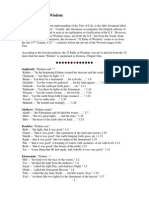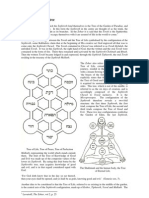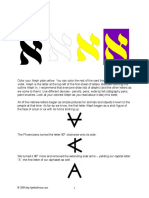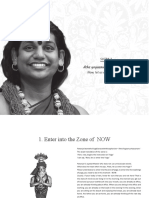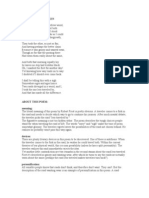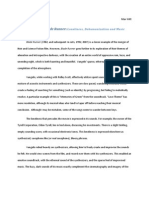Introduction To Kabbalistic Astrology PDF
Introduction To Kabbalistic Astrology PDF
Uploaded by
RamanasarmaCopyright:
Available Formats
Introduction To Kabbalistic Astrology PDF
Introduction To Kabbalistic Astrology PDF
Uploaded by
RamanasarmaOriginal Description:
Original Title
Copyright
Available Formats
Share this document
Did you find this document useful?
Is this content inappropriate?
Copyright:
Available Formats
Introduction To Kabbalistic Astrology PDF
Introduction To Kabbalistic Astrology PDF
Uploaded by
RamanasarmaCopyright:
Available Formats
clark4
top of page
An Introduction to Kabbalistic Astrology
Jonathon Clark
Kabbalah (Hebrew for receive) is an oral tradition of wisdom which traces its origins to early Biblical times. Legend tells us that God, wishing to behold His own image, created the Universe to act as a mirror. In order to serve God the work of the Kabbalist is the perfection of the (visible and invisible) world(s). In accordance with the maxim of as above, so below the position of the heavenly bodies has an effect on the physical world while the reverse also applies - as below, so above not only means that our actions in the physical world can lead to harmony or discord in the higher worlds but places a greater degree of responsibility for our actions upon us than we might otherwise think. One of the principal tools of Kabbalah is the diagram of the Tree of Life, consisting of ten circles linked by twenty-two paths and which describes the way the universe works. The diagram has three columns, or pillars - the right pillar symbolises expansion or energy and the left pillar symbolises form, structure or contraction while the middle pillar is known as the pillar of consciousness. Each circle (Sefirah in Hebrew, plural Sefirot) constitutes an aspect of God such as compassion, beauty or discernment while an eleventh circle (shown with dotted lines but not designated as a Sefirah) shows the place of knowledge (Daat). Since the diagram is said to represent the entire universe, any and every situation we encounter may be set upon the Tree including astrology. When these correspondences are examined interesting - and perhaps unexpected - insights may be gained.
file:///Users/jon/Sites/Kabbalah%20Society/%20New%20KS%20Site/clark4.html (1 of 7)8/12/2004 1:22:50 am
clark4
Each of the planets and the earth corresponds to one of the Sefirot. The diagram of the Tree (Figure 1) shows the Hebrew transliteration of each of the Sefirot together with the planetary correspondence.
Newcomers to Kabbalah who have some knowledge of astrology are often surprised to find that Mars, the planet of assertion, is to be found on the passive side of the Tree at Gevurah, while the peace-loving and harmonious Venus is placed on the active side of the Tree at Netzach. This can be explained by using the analogy of the martial artist whose essential mode of attack is non-movement, striking only occasionally and at precisely the right moment. Such discipline and judgement is the hallmark of Gevurah. Netzach, which corresponds to Venus, the young girl, symbolises the principle of attraction. Often it is she, rather than the man with whom she is about to form a relationship who makes eyes or moves her body in a suggestive sort of way to attract her mate - she is anything but passive. To the astrologer with a traditional outlook, however, the Kabbalistic placing is more logical, for the right hand side of the Tree emphasises growth and therefore contains the benefic planets, Venus and Jupiter while the left-hand side, symbolising destruction and decay contains the malefic planets, Mars and Saturn.
file:///Users/jon/Sites/Kabbalah%20Society/%20New%20KS%20Site/clark4.html (2 of 7)8/12/2004 1:22:50 am
clark4
Since moistness is associated with fertilisation and growth it is appropriate that the planets which have moist natures (Jupiter is warm and moist while Venus is cool and moist) should be on the active side of the Tree which symbolises growth. Conversely, Mars and Saturn both have dry natures (hot and dry for Mars, cold and dry for Saturn) and so are placed on the side of the Tree which symbolises destruction - nothing can grow without water. Both columns are necessary for existence to be sustained and in this context Mars and Saturn are to be welcomed as the destroyers that prepare the path for the new rather than shunned or avoided. Like the symbol of the Yin and Yang, where the dark portion contains the dot of light and vice versa, the Tree of Life shows that if existence becomes too staid then action eventually occurs automatically in order to move back to equilibrium while excessive action would eventually lead to the fragmentation of the universe and so a halt or contraction must be triggered in such circumstances in order to restore a balance. In living consciously we seek to be neither excessively active or passive but to hold fast to the central column of our consciousness drawing a measure amount of the qualities offered on either side of the Tree. Mercury, changeable in its nature, is placed on the left side of the Tree at Hod - reverberation. As with Mars and Saturn (see above) it has a dry (and cold) nature. Although Mercury takes on the nature of any planet with which it is placed in a chart, its essence is that of the juggler, throwing balls in the air but not actually moving forward. It is therefore more representative of form than energy and properly belongs on the passive side of the Tree of Life. The Moon and Sun represent ego consciousness and self-consciousness respectively - the everyday world of one who follows mass consciousness and the world of the true individual who acts according to his or her own conscience. The path between them is known as the path of honesty. Understanding the relationship between the Sun and Moon in this context can provide a new perspective in a natal chart. The Moon at Yesod symbolises the everyday world and the way we react to situations whereas the zodiac sign in which our Sun is place shows how we make our decisions from a higher perspective. The Moon at Yesod makes a good servant for we live in the everyday world and must deal with it accordingly. Our ego is invaluable for such a purpose but when the ego tries to usurp the position of the Sun as ruler of the personality it makes a poor master. When we observe someone apparently behaving out of line with their sun sign it is often because they are letting their Moon take charge. A good example of the interaction between Sun and Moon occurred in my work as a financial adviser. My clients Virgo Moon took control of most of our first and second meetings with many queries about detailed clauses of the pension contract we were discussing. This Virgoan flavour was so overwhelming that when I finally started to fill in application forms at the close of the second meeting I did so far more slowly than usual lest there be any mistake whatsoever, however small, which her Virgo Moon would find intolerable. After a minute or two my client suddenly said that she hoped we wouldnt be much longer as she had a lot to do. Without warning she had switched to her Aries Sun. The careful Virgo sensor, having done its work and told her that all was well with the proposal, was now able to submit to the Aries Sun which wanted to make swift decisions about the outstanding matters. If she had continued with her Virgo Moon in control we might never have finalised the contract or she would have inevitably found a fault which meant it did not go ahead - apparently in defiance of her Sun sign which wished to implement the plan. Placing the world of astrology on the Tree we can see the current debates are accurately reflected. On the right-hand pillar we have the innovators who, for example, might be interested in the latest asteroids while on the left hand pillar we have the traditionalists who are more concerned with retaining the knowledge of the past.
file:///Users/jon/Sites/Kabbalah%20Society/%20New%20KS%20Site/clark4.html (3 of 7)8/12/2004 1:22:50 am
clark4
The different methods of working are also shown by these two columns. To the right pillar belong the action-oriented astrologers - including sun-sign astrologers - while the left pillar describes the more academic approach, whether this relates to traditional or modern astrology. In Kabbalah, the ideal is to plot ones path along the central column drawing from the functional aspects of the Sefirot on either side as required while gradually raising ones consciousness. It is through this central column that we are each able to draw on the higher worlds and have the capability to imbue our work with the highest quality whether it is a sun-sign column or an essay on the use of the Arabic Parts. Many books on Kabbalah include reference to astrology but the main source on which I have drawn in this article is that of Zev ben Shimon Halevi who numbers among his spiritual ancestors the Spanish Kabbalistic astrologer of the twelfth century, Abraham ibn Ezra, and the Spanish poet of the eleventh century, Solomon ibn Gabirol. Ibn Ezra was both a commentator on the Torah (Five Books of Moses) and an astrologer whose most well-known astrological work is The Beginning of Wisdom. Ibn Gabirol, to whom Halevis book on astrology, The Anatomy of Fate, is dedicated, composed the epic poem Keter veMalkhut (The Crown and the Glory or The Royal Crown). This contains a litany of astrological description just pages before the list of sins for which orthodox Jews ask repentance on the Day of Atonement. Those who oppose astrology on religious grounds are not aware, one imagines, of such a connection. The diagram of the Tree was evolved in medieval Spain and while most modern Kabbalists are in agreement about the correspondences between the planets and the various Sefirot it is Halevis use of the extended Tree, or Jacobs Ladder as it has come to be called, which sets him apart and makes him the principal practitioner of what is now known as the Toledo Tradition (named for Toledo, Spain, where Kabbalah flourished in the fourteenth and fifteenth centuries).
file:///Users/jon/Sites/Kabbalah%20Society/%20New%20KS%20Site/clark4.html (4 of 7)8/12/2004 1:22:50 am
clark4
In the Jacobs Ladder (Figure 2) each of the four worlds Azilut (the Divine), Beriah (Creation or Spirit), Yetzirah (Forms) and Assiyah (Physical) overlap each other and it is upon the second lowest of these worlds, Yetzirah, that the planetary system we know as astrology may be placed. This is also known as the world which corresponds to the psyche of the human being, the understanding of which is frequently the object of astrological study.
While the Tree of Life diagram was evolved hundreds of years ago we have, of course, subsequently witnessed the discovery of Uranus, Neptune and Pluto. These have provisionally been placed at Hokhmah, Keter and Daat respectively and, as with all developments in Kabbalah, the validity of a proposition is tested by the question does it work? or does it make sense? Traditionally, the zodiac itself (representing the accumulated wisdom of all twelve constellations) was placed at Hokhmah and the First Swirlings (the beginnings of the universe) at Keter. Uranus, with its highly tilted orbit, certainly seems to symbolise the eccentric or the different while the nebulousness of
file:///Users/jon/Sites/Kabbalah%20Society/%20New%20KS%20Site/clark4.html (5 of 7)8/12/2004 1:22:50 am
clark4
Neptune appears to encapsulate something of the quality of Keter. Pluto, with an orbital inclination of seventeen degrees to the ecliptic, hardly belongs to the solar system, according to Halevi, and therefore corresponds to Daat, which forms an access point to the next highest world. Before the discovery of these planets Saturn, so slow in motion compared with the other visible planets and bounded by rings, represented the sole point of connection with the higher world and the limits of known existence. In horary astrology, which is predominantly concerned with the mundane affairs of mankind it would seem inappropriate to include these planets in the judgement. In the grander scale of eclipses and ingresses the transpersonal planets may well have something to say to us. Although the ancients managed perfectly well without them we should note that the scale of time as perceived by humankind has itself changed with the advent of modern methods of travel and communication. Since the discovery of the modern planets with Uranus, instead of the zodiac being placed at Hokhmah, the signs of the zodiac have been distributed around the various triangles of the Tree of Life - the placings and reasons for these attributions is outside the scope of this article which is only a an introduction to the subject. Although, at first sight, the diagrams of the Tree of Life and Jacobs Ladder may appear complex they are of stunning simplicity when compared with much Kabbalistic literature! While articles such as this may serve as an introduction they are only about Kabbalah which is an oral tradition. For this writer, astrology provided a the bridge he needed from the sterility he observed in the general practice of his religious tradition and the teaching which, although it had always been available, had remained unknown to him. The (spiritual) law, as the Bible says (Proverbs 3:18), is a Tree of Life to those that grasp hold of it. And for those who do Its ways are ways of pleasantness and all its paths are peace. (Proverbs 3:17)
Reference List The Anatomy of Fate by Zev ben Shimon Halevi, Arkana. Psychology and Kabbalah by Zev ben Shimon Halevi, Gateway Books. Kabbalah: Tradition of Hidden Knowledge by Zev ben Shimon Halevi, Thames and Hudson A Kabbalistic Universe by Zev ben Shimon Halevi, Samuel Weiser Inc. The Beginning of Wisdom by Abraham ibn Ezra, English Translation edited by Raphael Levy and Francisco Cantera. Available from Ascella Publications, 3 Avondale Bungalows, Sherwood Hall Road, Mansfield, Notts. England NG18 2NJ or from JustUs and Associates, 1420 N.W. Gilman Blvd., Suite #2154, Issaquah, WA 98027-7001 USA. Selected Religious Poems of Solomon ibn Gabirol, edited by Israel Davidson, Jewish Publication Society of America.
Back to top Jonathon Clark
file:///Users/jon/Sites/Kabbalah%20Society/%20New%20KS%20Site/clark4.html (6 of 7)8/12/2004 1:22:51 am
clark4
file:///Users/jon/Sites/Kabbalah%20Society/%20New%20KS%20Site/clark4.html (7 of 7)8/12/2004 1:22:51 am
You might also like
- Meleen M - Book M Liber Mundi 2015Document75 pagesMeleen M - Book M Liber Mundi 2015alena.glbNo ratings yet
- The Kabbalistic Mirror of Genesis: Commentary on the First Three ChaptersFrom EverandThe Kabbalistic Mirror of Genesis: Commentary on the First Three ChaptersRating: 5 out of 5 stars5/5 (4)
- Book 06 The Sacred Tarot CC Zain PDF FreeDocument176 pagesBook 06 The Sacred Tarot CC Zain PDF Freemanelius89100% (3)
- Taittiriya Upanishad Sanskrit PDFDocument163 pagesTaittiriya Upanishad Sanskrit PDFsridharrudraveena100% (1)
- The 32 Paths of WisdomDocument64 pagesThe 32 Paths of WisdomShri Moorthy100% (9)
- Kabbala Digital PDFDocument360 pagesKabbala Digital PDFBienkowski Pawel100% (8)
- The Tree of Life - Tarot HermeneuticsDocument26 pagesThe Tree of Life - Tarot HermeneuticsOmar Cayasso100% (1)
- Kaplan - Sefer Yetzirah, The Book of Creation in Theory and PracticeDocument423 pagesKaplan - Sefer Yetzirah, The Book of Creation in Theory and PracticeGeorgios Pletho100% (35)
- Ma'Aseh Merkabah LiteratureDocument84 pagesMa'Aseh Merkabah Literaturegetulionetto100% (2)
- The Hebrew Letters, A Workbook (Best Quality) by Paul Foster CaseDocument82 pagesThe Hebrew Letters, A Workbook (Best Quality) by Paul Foster CaseRoger Christian Cruz100% (15)
- Essence of Sahasra LingarchanaDocument67 pagesEssence of Sahasra LingarchanasriramanaNo ratings yet
- Learn Zohar Part 6Document85 pagesLearn Zohar Part 6jonn1e100% (2)
- Tarot and KabalahDocument297 pagesTarot and KabalahDonald William100% (5)
- Kabbalah TreeDocument10 pagesKabbalah TreeTito Asisclo Hernández100% (1)
- The Ten Sephiroth: Source. Divine Chochma, The Limitless Flash of Wisdom Beyond Grasp, PredominatesDocument13 pagesThe Ten Sephiroth: Source. Divine Chochma, The Limitless Flash of Wisdom Beyond Grasp, PredominatesStephen Murtaugh100% (1)
- The Practical Kabbalah (Vol. 2) - Ambelain, Robert PDFDocument176 pagesThe Practical Kabbalah (Vol. 2) - Ambelain, Robert PDFJosé Mato Alvarez100% (1)
- Kabbalah For BeginnerDocument4 pagesKabbalah For Beginneradrianccc100% (1)
- Kabbalistic Tarot: Hebraic Wisdom in the Major and Minor ArcanaFrom EverandKabbalistic Tarot: Hebraic Wisdom in the Major and Minor ArcanaRating: 4 out of 5 stars4/5 (6)
- Ancient Moon Wisdom: The Kabbalistic Wheel of Astro Mystery and its Relationship to the Human ExperienceFrom EverandAncient Moon Wisdom: The Kabbalistic Wheel of Astro Mystery and its Relationship to the Human ExperienceNo ratings yet
- Unaspected PlanetsDocument4 pagesUnaspected PlanetsRamanasarmaNo ratings yet
- The Ascetic of DesireDocument7 pagesThe Ascetic of DesireRamanasarmaNo ratings yet
- List of Goosebumps BooksDocument14 pagesList of Goosebumps Booksapi-39838407725% (4)
- 5 Ds ReviseDocument42 pages5 Ds Revisesubashri balasubramanianNo ratings yet
- Tarot Kabbalah 1Document7 pagesTarot Kabbalah 1HugoSalinasRiveraNo ratings yet
- Kabbalah: The Tree of LifeDocument4 pagesKabbalah: The Tree of LifeVEHN JAMES VENGCONo ratings yet
- KabbalahDocument14 pagesKabbalahCesar Dos Anjos100% (4)
- Kabbalah: The Tree of LifeDocument4 pagesKabbalah: The Tree of LifeYola Flores Isfer100% (1)
- Codes Revealed - Kabbalah On RelationshipsDocument21 pagesCodes Revealed - Kabbalah On RelationshipsdreamwebworldNo ratings yet
- Te T Rag Ramaton SPR Ead: Step 1: Pick A SignificatorDocument7 pagesTe T Rag Ramaton SPR Ead: Step 1: Pick A SignificatorSihaya NúnaNo ratings yet
- The Kabbalah Experience - The Practical Guide To Kabbalistic WisdomDocument474 pagesThe Kabbalah Experience - The Practical Guide To Kabbalistic WisdomLeonardo Pers100% (7)
- Alphabet of Kabbalah - IntroductionDocument34 pagesAlphabet of Kabbalah - IntroductionvfallikNo ratings yet
- Angels and The ZodiacDocument609 pagesAngels and The Zodiacsatya1401100% (1)
- Tarot and Kabbalistic Sacred Geometry - J.SDocument20 pagesTarot and Kabbalistic Sacred Geometry - J.SBodibodi100% (2)
- The 32 Paths of WisdonDocument76 pagesThe 32 Paths of WisdonJessie Elija100% (3)
- The 11th Path Chokmah Kether: The Scintillating (Fiery) IntelligenceDocument44 pagesThe 11th Path Chokmah Kether: The Scintillating (Fiery) IntelligenceDanielle Grace100% (1)
- Yael Yardeni Astrology Seminar 20090603 English PDFDocument10 pagesYael Yardeni Astrology Seminar 20090603 English PDFFederico AndradeNo ratings yet
- Rawn, Clark - 32PathsOfWisdomDocument64 pagesRawn, Clark - 32PathsOfWisdompacodosmil100% (2)
- AlephDocument8 pagesAlephFrater MagusNo ratings yet
- Qaballah and Tarot: A Basic Course in Nine Lessons. Lesson IIDocument42 pagesQaballah and Tarot: A Basic Course in Nine Lessons. Lesson IIPolaris93100% (1)
- KaphDocument7 pagesKaphFrater MagusNo ratings yet
- Fixed Tree of Life (Sefer Yetzirah)Document1 pageFixed Tree of Life (Sefer Yetzirah)Chance Jason KallistiNo ratings yet
- Qabbalah of The MagiciansDocument39 pagesQabbalah of The MagiciansIadnon100% (7)
- Introduction To The Wisdom of Kabbalah ContentDocument502 pagesIntroduction To The Wisdom of Kabbalah ContentJonhul WuNo ratings yet
- Moon MansionsDocument2 pagesMoon MansionsAmer Shah100% (2)
- Gematria Sepher Sapphires Volume 2 Part 2 PDFDocument96 pagesGematria Sepher Sapphires Volume 2 Part 2 PDFalana100% (1)
- Gazing Into HUA - The Archangelic Presence of The MessiahDocument5 pagesGazing Into HUA - The Archangelic Presence of The MessiahMarkosNo ratings yet
- Evolution of The KabbalahDocument58 pagesEvolution of The KabbalahJudith Robbins100% (1)
- Malkuth: The KingdomDocument3 pagesMalkuth: The KingdomGiniti Harcum El Bey100% (1)
- A Basic Meditation Technique of The Kabbalah - Chanting The Name JHVHDocument3 pagesA Basic Meditation Technique of The Kabbalah - Chanting The Name JHVHAnonymous ofwFwNtM100% (1)
- Tarot DecansDocument2 pagesTarot DecansEhuatlNo ratings yet
- Decoding Magic and Kabbalah - Windows On The WorldDocument7 pagesDecoding Magic and Kabbalah - Windows On The Worldjgalindes75% (4)
- Order of St. Raphael Study Guide - Magdalene CircleDocument84 pagesOrder of St. Raphael Study Guide - Magdalene CircleMarcos MarcondesNo ratings yet
- Learning The Tree of Life Through MEDITATIONDocument25 pagesLearning The Tree of Life Through MEDITATIONvfallik100% (3)
- 28 Questions of KabbalahDocument16 pages28 Questions of KabbalahSean NeddNo ratings yet
- 7 NetzachDocument2 pages7 NetzachFrater FurnulibisNo ratings yet
- A Journey Through The Tree of Life PDFDocument24 pagesA Journey Through The Tree of Life PDFVasile Ioan Stoian100% (1)
- Tarot 20121130 001242Document2 pagesTarot 20121130 001242anon_503938883No ratings yet
- Thoth Major Arcana Cheat SheetDocument10 pagesThoth Major Arcana Cheat SheetBrenda AcostaNo ratings yet
- Tarot and the Gates of Light: A Kabbalistic Path to LiberationFrom EverandTarot and the Gates of Light: A Kabbalistic Path to LiberationRating: 5 out of 5 stars5/5 (2)
- Sefer Yetzira: Chronicles of DesireFrom EverandSefer Yetzira: Chronicles of DesireHershy J. WorchNo ratings yet
- A Map of the Universe: An Introduction to the Study of KabbalahFrom EverandA Map of the Universe: An Introduction to the Study of KabbalahNo ratings yet
- 49 Gates of Light: A Course In KabbalahFrom Everand49 Gates of Light: A Course In KabbalahRating: 5 out of 5 stars5/5 (1)
- Ancient Nepal 59-60 05 PDFDocument16 pagesAncient Nepal 59-60 05 PDFRamanasarmaNo ratings yet
- Ancient Mother Goddesses and Fertility CultsDocument13 pagesAncient Mother Goddesses and Fertility Cultsbthistlethwaite56980% (1)
- Essence of Virat Parva of Maha BharataDocument76 pagesEssence of Virat Parva of Maha BharataRamanasarmaNo ratings yet
- Balaarista YogaDocument4 pagesBalaarista YogaRamanasarmaNo ratings yet
- Bromances From Mythology: Our Ancient Texts Are About All Kinds of Unions. Modern India Could Do With Some Catching UpDocument4 pagesBromances From Mythology: Our Ancient Texts Are About All Kinds of Unions. Modern India Could Do With Some Catching UpRamanasarmaNo ratings yet
- DeclomycineDocument14 pagesDeclomycineRamanasarmaNo ratings yet
- 32524rtpfinalmay2014 4 PDFDocument28 pages32524rtpfinalmay2014 4 PDFRamanasarmaNo ratings yet
- Barack Obama HoroscopeDocument19 pagesBarack Obama HoroscopeRamanasarma100% (1)
- Child'S Horoscop E: Astrological Interpretation and Text Liz Greene Programming Alois TreindlDocument28 pagesChild'S Horoscop E: Astrological Interpretation and Text Liz Greene Programming Alois TreindlRamanasarmaNo ratings yet
- Hideous and KinkyDocument9 pagesHideous and KinkyRamanasarma100% (2)
- Beyond Polyandry Exploring Draupadi's Desires' in Chitra Banerjee Divakaruni's The Palace of Illusion'Document8 pagesBeyond Polyandry Exploring Draupadi's Desires' in Chitra Banerjee Divakaruni's The Palace of Illusion'RamanasarmaNo ratings yet
- Full Moon in The SignsDocument1 pageFull Moon in The SignsRamanasarmaNo ratings yet
- Beyond Polyandry Exploring Draupadi's Desires' in Chitra Banerjee Divakaruni's The Palace of Illusion'Document8 pagesBeyond Polyandry Exploring Draupadi's Desires' in Chitra Banerjee Divakaruni's The Palace of Illusion'RamanasarmaNo ratings yet
- Masculinity of Arjuna and Sri KrishnaDocument8 pagesMasculinity of Arjuna and Sri KrishnaRamanasarmaNo ratings yet
- Dohsa (Negative Yoga) Covered by Divya Dristi MuhurthaDocument19 pagesDohsa (Negative Yoga) Covered by Divya Dristi MuhurthaRamanasarma100% (2)
- Astro Death Horime A and Primary DirectionsDocument7 pagesAstro Death Horime A and Primary DirectionsRamanasarma100% (1)
- Devi Rahasya TantraDocument6 pagesDevi Rahasya TantraRamanasarma100% (1)
- Role of Indian Folk Culture in Promotion of Tourism in The CountryDocument5 pagesRole of Indian Folk Culture in Promotion of Tourism in The CountryRamanasarmaNo ratings yet
- Moon and SaturnDocument4 pagesMoon and SaturnRamanasarmaNo ratings yet
- Woman's GaitDocument12 pagesWoman's GaitRamanasarma100% (1)
- Gossip and Grahas ColorDocument3 pagesGossip and Grahas ColorRamanasarmaNo ratings yet
- Pluto Ascendant Aspect: Becoming A Different PersonDocument3 pagesPluto Ascendant Aspect: Becoming A Different PersonRamanasarma100% (1)
- Swarnamruta PraasanDocument5 pagesSwarnamruta PraasanRamanasarmaNo ratings yet
- Astro AmericaDocument3 pagesAstro AmericaRamanasarmaNo ratings yet
- You Gotta Know: Avatar, or Incarnation. Nine Have Appeared So Far: Matsya, Kurma (Tortoise)Document3 pagesYou Gotta Know: Avatar, or Incarnation. Nine Have Appeared So Far: Matsya, Kurma (Tortoise)RamanasarmaNo ratings yet
- Functions of Female OrgasmDocument6 pagesFunctions of Female OrgasmRamanasarmaNo ratings yet
- ChaaturmaasyamDocument2 pagesChaaturmaasyamRamanasarmaNo ratings yet
- City of Mist RPG - Crew ThemesDocument1 pageCity of Mist RPG - Crew ThemesMikaNo ratings yet
- Honor Band Sight Reading Etudes: by Clifton TaylorDocument1 pageHonor Band Sight Reading Etudes: by Clifton TaylorHannah SeokNo ratings yet
- Ecclesiology - and - Globalization Kalaitzidis PDFDocument23 pagesEcclesiology - and - Globalization Kalaitzidis PDFMaiapoveraNo ratings yet
- Chola Empire History Study Material NotesDocument3 pagesChola Empire History Study Material NotesmonikasamhiNo ratings yet
- Hartmann: Concerto Funebre Sonatas & Suites For Solo ViolinDocument23 pagesHartmann: Concerto Funebre Sonatas & Suites For Solo ViolinDominikaSkórkaNo ratings yet
- Polygon CLippingDocument15 pagesPolygon CLippingDhana Lakshmi BoomathiNo ratings yet
- Pag 40 A Contra CapaDocument10 pagesPag 40 A Contra CapaMarcos PiovezanNo ratings yet
- 1 PDFDocument2 pages1 PDFPradosh Kumar PanigrahyNo ratings yet
- Patanjali Yoga SutrasDocument266 pagesPatanjali Yoga SutrasMa Brahmanandamayee100% (1)
- English 10-1st Qurter Exam Aug.23-24Document7 pagesEnglish 10-1st Qurter Exam Aug.23-24Felix Ray DumaganNo ratings yet
- FC - 1A - Unit 5Document10 pagesFC - 1A - Unit 5Phạm DũngNo ratings yet
- Present Simple TenseDocument7 pagesPresent Simple TenseMasshelk Mireyda HMNo ratings yet
- Miniature Oxhide Ingots From Cyprus: Old and New Questions: Francesca MeneghettiDocument1 pageMiniature Oxhide Ingots From Cyprus: Old and New Questions: Francesca MeneghettiSezer AlemdarNo ratings yet
- The Curse of The Werewolf - (Werewolve/Vampire)Document2 pagesThe Curse of The Werewolf - (Werewolve/Vampire)LuschersUnderworldNo ratings yet
- Inked Etc - No.5Document44 pagesInked Etc - No.5pier aaronNo ratings yet
- Elvis Hsu: SPOSAD Design Camp Share For SPOSAD110Document9 pagesElvis Hsu: SPOSAD Design Camp Share For SPOSAD110F34051176許宣智No ratings yet
- Materi My Family 1 (English) - Pertemuan 1Document6 pagesMateri My Family 1 (English) - Pertemuan 1Aulia Nur EndayaniNo ratings yet
- Bhrighu Saral Paddathi-34 BW Final PDFDocument14 pagesBhrighu Saral Paddathi-34 BW Final PDFGarga100% (1)
- Leonardo Da VinciDocument13 pagesLeonardo Da VinciKumar SarthakNo ratings yet
- Ancestors of The West: World Religions: A Voyage of DiscoveryDocument11 pagesAncestors of The West: World Religions: A Voyage of DiscoverysaintmaryspressNo ratings yet
- Untitled 1Document15 pagesUntitled 1SporkosophyNo ratings yet
- Saveetha College of Physiotherapy Saveetha University Rules and Regulations For Cultural Events Stride'17Document3 pagesSaveetha College of Physiotherapy Saveetha University Rules and Regulations For Cultural Events Stride'17lejizixNo ratings yet
- Editorial Cartooning Emmarie SeseDocument10 pagesEditorial Cartooning Emmarie SeseJoemar Furigay100% (1)
- F 1Document7 pagesF 1satyNo ratings yet
- The Roads Not TakenDocument3 pagesThe Roads Not TakenJHe Nii' MourenthyNo ratings yet
- The Story of JonahDocument2 pagesThe Story of Jonahcitra palapaNo ratings yet
- Blade Runner and VangelisDocument2 pagesBlade Runner and VangelisMaxWitt0% (1)




